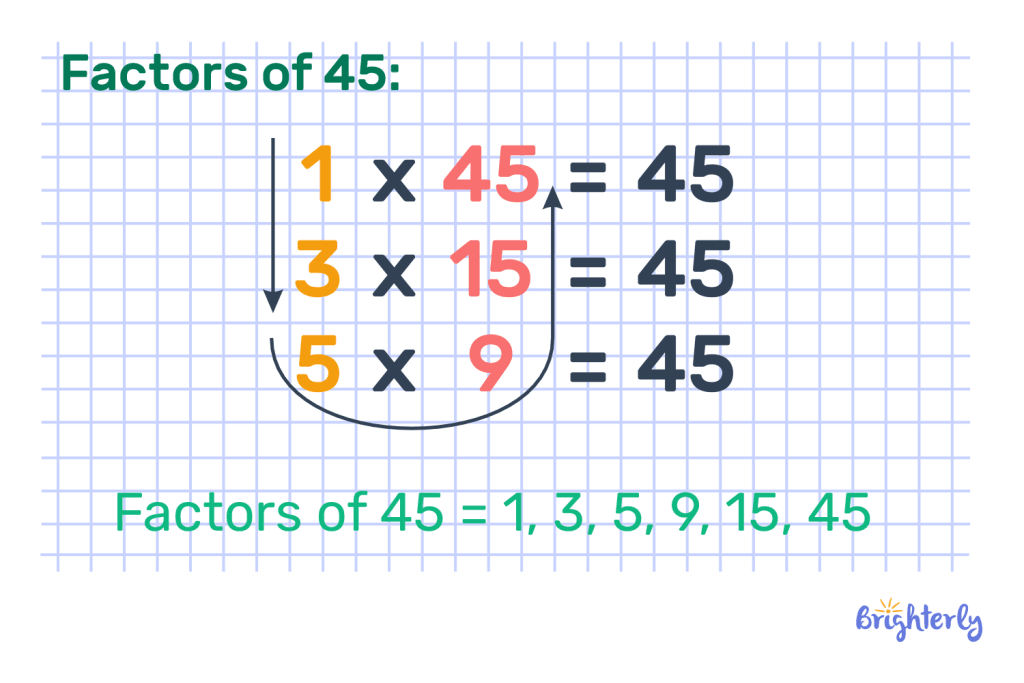Factors of 45 – Definition With Examples
Updated on November 3, 2025
In math class, you’ll learn all about factors. They’re a key element of math and allow you to understand multiplication and division more deeply.
To help you with your understanding of factors, today we’re going to explore the factors of 45. We’ll explain what factors are, list them, and take a look at their properties. We’ll also share some practice problems so you can hone your skills in this area.
What are factors?
Factors are integers (whole numbers) that can be multiplied by another integer to total a given number. So if we look at the number 45, its factors are numbers that can be multiplied by other numbers to make 45. These numbers combined with the numbers they are multiplied by are called factor pairs.
What is the factor of 45?
The factor of 45 is any number that is divisible by 45 without any remainders. In other words, these numbers can be multiplied by other whole numbers to give us the total of 45.

Definition of factors of 45
The definition of factors of 45 are any integers that can be multiplied by other integers to make the number 45. Another way to put it is that 45 is divisible by these numbers without any remainders.
You can find the factors of 45 by going through numbers from 1 and seeing if they can be multiplied by another whole number to make 45.
List of factors of 45
- 1
- 3
- 5
- 9
- 15
- 45
You can also group the factors of 45 in pairs:
- 1 x 45 = 45
- 3 x 15 = 45
- 5 x 9 = 45
Properties of factors of 45
There are some interesting properties of the factors of 45. Let’s take a look at them here:
- The number 1 is known as the multiplicative identity, meaning any number multiplied by the number 1 will result in itself
- Number 3 is the second-smallest prime number and a component of the Pythagorean triple (3, 4, 5)
- The number 5 is a Fibonacci number and is also a component of the smallest Pythagorean triple
- Number 9 is a square number — is is the square of the number 3, another factor of 45
- The number 15 is a pentatope number
- Number 45 is a triangular number, as it is the sum of 1 + 2 + 3 + 4 + 5 + 6 + 7 + 8 + 9
Properties of prime factors of 45
45 has 2 prime factors: the numbers 3 and 5. This means those numbers are only divisible by themselves and 1.
Prime numbers have fascinating properties, so let’s explore the properties of the prime factors of 45:
- The number 3 is a triangular number, meaning the sum of the first 2 numbers equals the number: 1 + 2 = 3
- The number 5 is the sum of the first 2 prime numbers: 2 + 3 = 5
Properties of composite factors of 45
The remaining factors 45 — 9, 15 and 45 — still have their own interesting properties. Let’s take a look at them:
- The number 9 is the largest single-digit number and in numerology, is considered perfect, complete and divine
- The number 15 is also a triangular number, as it is the sum of 1 + 2 + 3 + 4 + 5
- Number 45 is a deficient number
Difference between prime and composite factors of 45
The difference between the prime and composite factors of 45 is whether or not they have factors themselves beyond 1 and the number themselves. Our prime factors, 3 and 5, are only divisible by 1 and themselves. Meanwhile, our composite factors of 9, 15 and 45 have many more of their own factors.
Practice problems on finding factors for 45
Now, it’s time for you to try out some practice problems related to factors 45. You can either solve these problems mentally or write them down. The more you practice factors questions, the better you’ll get!
- You have 45 cards to share out between 9 friends in a card game. How many cards does each person get?
- List out all of the composite factors of 45 and show your working out. How do you know they are composite factors and not prime factors?
- Write the prime factorization of 45 and show your working
Conclusion
Here, we’ve covered the definition of factors, listed all the factors of 45 and covered their interesting properties. Every time you learn about the factors of a number, you become more knowledgeable about factors as a whole. Now, you can confidently approach factors, as well as multiplication and division, in your math class and in exams.
Factors of 45: Frequently asked questions
What are the factors of 45?
The factors of 45 are 1, 3, 5, 9, 15 and 45. All of these integers can be multiplied by another integer to create the number 45. Another way to put this is that all of these numbers are divisible by 45 with no remainders left over.
What are all the factors of 45?
- 1
- 3
- 5
- 9
- 15
- 45
They can also be put into the factor pairs of 45:
- 1 x 45 = 45
- 3 x 15 = 45
- 5 x 9 = 45
Is 45 prime or composite?
45 is a composite number. That’s because 45 has more factors than just 1 and itself. Prime numbers, meanwhile, are only divisible by 1 and 45, meaning they have no other factors. 45 has 6 factors in total, making it a composite number.
What is the prime factorization of 45?
The prime factorization of 45 is 3 x 3 x 5. Find this by dividing 45 by its smallest prime factor and continuing: 45 ÷ 3 = 15.
15 ÷ 3 = 5. Then, divide by your next smallest prime number: 5 ÷ 5 = 1. Combine those numbers to 32 x 5.






